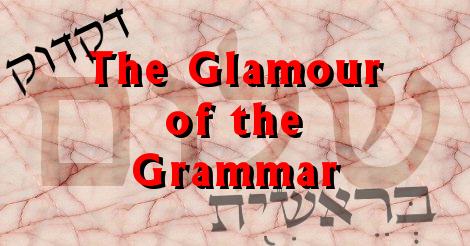New nouns enter Hebrew in multiple ways. Today we’ll look at three of them.
The first, onomatopoeia (literally, “word making”) is when a word reflects the sound associated with what it represents. Nearly every language has this process. In antiquity, it produced one of my favorite Hebrew words: bakbuk. It means “bottle,” and it sounds like what happens when liquid is poured from it: bakBUKbakBUK…. Other examples include ra’am (“thunder”) and the almost-cruel m’gam’g’man (“stutterer” — an equally unfair English example of onomatopoeia).
A “fly” in Hebrew is a zvuv, reflective of the zvzvzvzvzv sound the insect makes. (People who think they don’t let small things bother them haven’t spent time in a room with one zvuv.) Perhaps in recognition of the subtle insipid squeaking of the fly, one name for the Devil is ba’al-zvuv, that is “fly-lord.” When William Golding chose a slight variation of this translation — “Lord of the Flies” — for the title of his book, he used a classic combination of Hebrew imagery and onomatopoeia to allude to the Devil’s presence.
A second way to make words in Hebrew is more modern: two words are crammed together to create a third. From remez (“hint”) and or (“light”) we get ramzor, “traffic light.” (Hopefully the traffic light is more than a hint, though, sadly, traffic statistics in Israel suggest otherwise.) Vowels in Hebrew change to fit their linguistic circumstances, so remez becomes ramz here. In a similar vein, zarak is “threw,” and zarkor is a “spotlight.” Kaspomat, that is, “ATM,” or “automated teller machine,” but really “money vending machine,” comes from kesef (“money”) and otomat (“automat” or “vending machine”). In future weeks we’ll address why and how the vowels change, and why the “f” of kesef becomes a “p.”
When the end of the first word matches the start of the second, the overlapping sections appear only once. A particularly clever word-coiner melded rechev (“vehicle”) with kevel (“cable”) to mean “cable car” (or “tram,” “ski lift,” etc.). The words share two letters — “ch” and “k” are the same letter — and together form rakevel, or, more popularly, rachbal.
A third way to create new nouns is almost unique to Hebrew, which is classically based on roots of three, four or two letters. (I put “three” first not to confuse the counting but because triliteral roots are the commonest.) The usual observation that roots have meanings is almost right. More accurately, the roots contribute to the meanings of the words that are formed from them when the roots are merged into word patterns.
For example, the root G.D.L doesn’t actually mean “big,” but verbs from that root frequently have to do with “big”: gadal (“grew”), higdil (enlarged), etc. Nouns are similar: godel is “bigness,” which in English we call “size.”
While some patterns are general, being used for almost any sort of noun, others are more specific. Put a Mem in front of a root and adjust the vowels accordingly, and you get a tool. A boreg is a screw. Take the root letters (B.R.G), add a Mem, adjust the vowels, and you get mavreg: screwdriver. (Once again, “b” and “v” alternate.) Gihetz is “he ironed” and a maghetz is the noun “iron.” The reader may wish to guess the tools that come from Ch.Sh.V (“think”), K.R.R (“cool”), P.T.Ch (“open”), and Sh.P.Ch (“pour”), that is, machshev, makrer, maftei’ach, and mashpech. The answers appear at the end of the column.
Another noun pattern, consisting of the root plus a final Tav, with two /e/ vowels toward the end of the word, is used for diseases. A kelev is a “dog,” and kalevet is “rabies.” Ademet, from A.D.M (“red”) is “rubella,” while tzahevet, from Tz.H.V (“yellow”) is “jaundice.” Sukar is “sugar” is sukeret is “diabetes.” Katzeret (from K.Tz.R, “short”) is not dwarfism but rather asthma, that is, shortness of breath. Another of my favorite Hebrew words comes from niyar (“paper”) in the disease-pattern: nayeret.
Before turning to what that word means, here are English translations of the tools from two paragraphs ago. They are, respectively, “computer,” “refrigerator,” “key,” and, the hardest of the lot, “funnel.”
And what about the “paper-disease”? Nayeret means “bureaucracy.”
[Originally published December 28, 2007.]

These posts make my day! Between your writing and my conversational Hebrew class with Ezra Kedar, my fascination with our language keeps growing.
LikeLike
This delightful post reminds me that I also wrote a couple hundred pieces on the vagaries of the language I love/hate. An easy tongue to play games with, though it took me several years to even get started having fun. Oh and I do love to coin new ‘disease’ names in conversation; plenty of annoying symptoms to upgrade to their full illness status, as you doubtless know well.
Thanks again for the read. Add: Now that I think a second, is ‘casefet’ a state of too-much or too-little money in one’s circulatory system?/ Yonatan/ Qadima
LikeLike